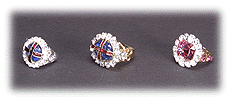
The Coronation Rings The Sovereign's Ring (centre).
Made for William IV. It weighs 84.45 carats, the large sapphire measures 15.2 x 12.2 x 7.4 mm and is surrounded by 14 diamonds. Five rubies are clear-set on the sapphire in the form of a cross. The Sovereign's Ring was made for William IV, and it has been used at every coronation since then (with the exception of Queen Victoria). Until that time it was customary to make a new ring for each monarch. It was destroyed at the king's death. The Sovereign's Ring is also called "The Wedding Ring of England", and is worn on the ring finger of the right hand.Queen Victoria's Ring (left).
It weighs 42.74 carats, the large sapphire measures 14.6 x 13.2 x 8.5 mm and is surrounded by 20 diamonds. Five rubies are clear-set on the sapphire in the form of a cross. This ring was made for Queen Victoria in 1838. The words "Queen Victoria's Coronation Ring" are engraved on the inside of the ring. Its design is identical to the Sovereign's Ring. William IV's coronation ring could not be adjusted to fit Victoria's small fingers at her coronation, and so she had a smaller version of the existing coronation ring made. Unfortunately, shortly beforehand the finger count had been changed. The ring was to be made for the fourth finger - the ring finger according to the old finger count, which was now the little finger according to the new count. The jeweller followed the new system, and thus made the ring for the little finger. However, at the coronation the Archbishop insisted on placing the ring on the correct finger. It is said that it took two hours and a lot of ice to remove the ring. For a long time it was believed that the tighter the ring fitted the monarch's hand, the more he or she would be loved by the people, and the longer the reign. Queen Victoria reigned for 63 years!Queen Consort's Ring (right).
Made in 1831 for Queen Adelaide, the wife of William IV. It weighs 50.15 carats, the large ruby measures 12.5 x 9.0 x 5.9 mm and is surrounded by 14 diamonds. Small rubies are set in the shank. Since Henry III (1216-1272) a ruby had been used as the central stone in the coronation ring, as it was considered to be the most beautiful of the precious stones. The ring for the coronation of George IV (1820-1830) departed from this tradition, and he had a ring made with a large sapphire head. Here rubies were only used in the form of a cross overlaying the sapphire, as was later the case with William IV's ring. Queen Adelaide's ring thus renews the old tradition with a ruby as the central stone.(Antje Beutel, Rebecca Jähner M.A., translated by Hugh Langridge M.A.)

